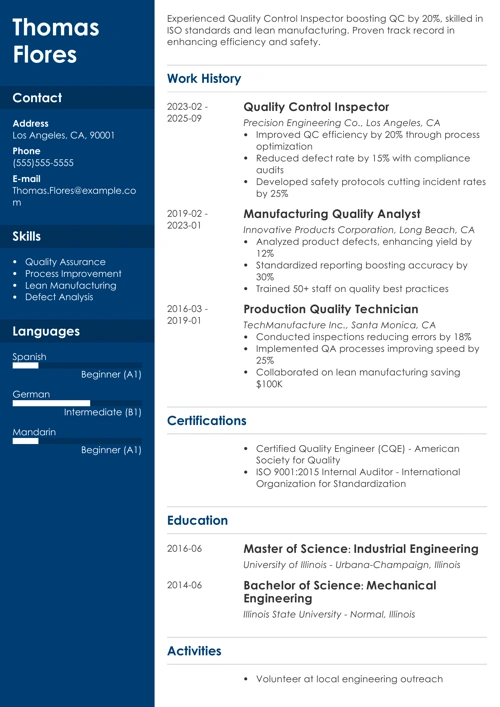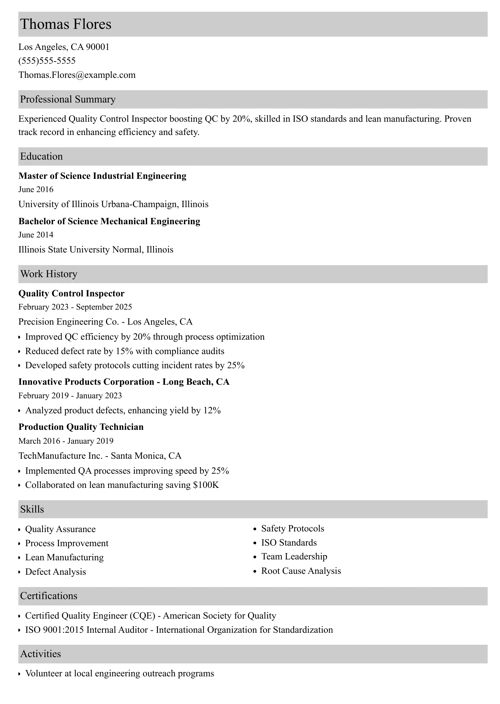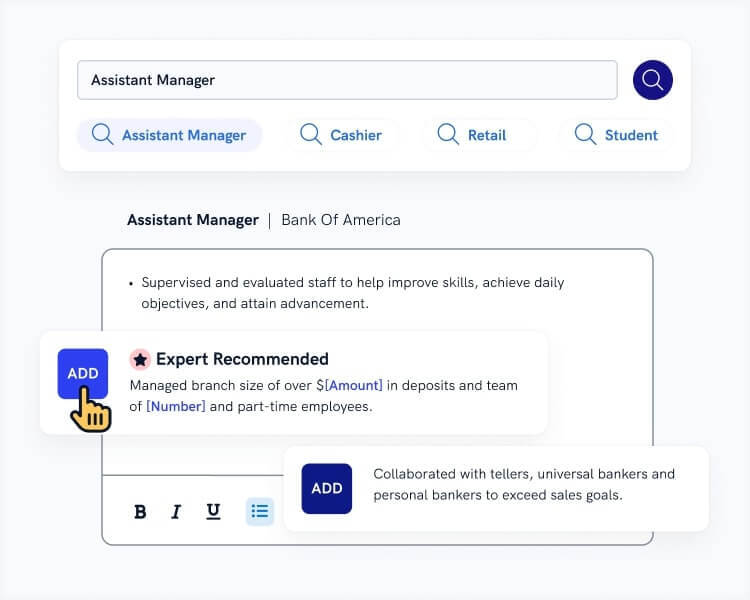Following up on a job application can be tricky—you don’t want to seem pushy, but you also want to stay informed about your status.
This guide will walk you through the best practices for following up professionally. You’ll learn when and how to follow up, key mistakes to avoid, and actionable tips to increase your chances of getting a response. Plus, you’ll see an example of an effective follow-up message. Let’s get started!
Want to save time and have your resume ready in 5 minutes? Try our resume builder. It’s fast and easy to use. Plus, you’ll get ready-made content to add with one click. See 20+ resume templates and create your resume here.
Sample resume made with our builder—See more resume examples here.
One of our users, Brittanya, had this to say:
Zety really helped me create the best resume possible. It pointed out how things could be better on my existing resume and suggested many things to be re-worded or removed.
How to Follow Up If You Applied for a Job
You've submitted the best version of your resume. Congratulations! Yet, it's just the beginning of the hiring process. You have to give the employers some time to review your application before you can follow up.
Here’s how to follow up on your job application effectively:
1. Wait Enough Time
When to follow up on a job application? There’s no fixed rule, but generally, you should follow up no sooner than a week after submitting your resume. Two weeks and no job offer letter coming your way? Now, you definitely have to follow up.
There’s one instance in which you don’t have to worry about timelines, employer preference, or waiting “long enough”. It’s when you’re offered a position with a different company, but still haven’t heard back from your top pick. If such is the case, follow up straight away.
2. Check the Job Posting
Before you follow up, have another look at the job posting. Sometimes, employers explicitly state that they don’t want you to reach out to them to ask about your application status at this stage.
In other cases, the exact response date is provided in the job ad. Play by the rules. Following up before the due date will be rude at best and will hamper your chances of landing the job at worst.
3. Choose the Right Way of Communication
Following up via email is often the most preferred way of contact. It provides a written record of the communication between you and the hiring manager, enabling easy correspondence tracking. From your point of view, it allows you to express your sincere interest in the job in an organized manner.
4. Highlight Your Qualifications
Remind the hiring manager of your candidature by stating the position you applied for and the date you sent it. When following up on your application by email, briefly reiterate your key qualifications that match the job requirements. Underline the skills and top accomplishments that make you a competitive candidate.
5. Show Your Gratitude
When sending a job follow-up email, thank the recruiter for considering your candidacy. Highlight details and specific aspects of the company or the position you apply for that resonate with you most. At the end, say that you look forward to discussing your qualifications and the opening you’ve applied for.
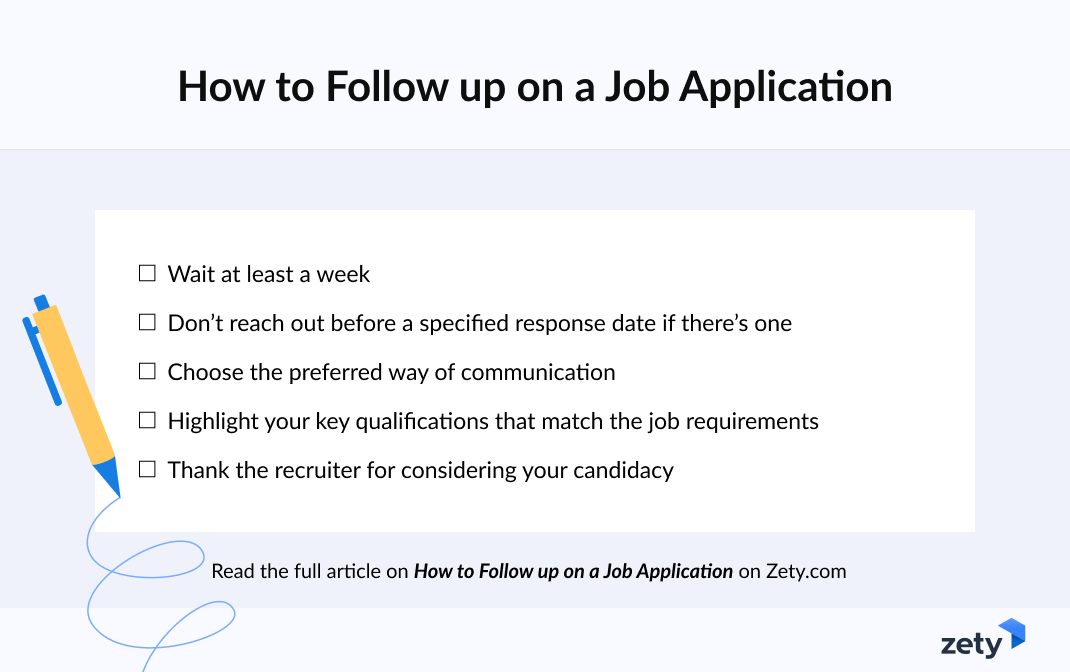
Pro Tip: Research the company’s values and missions and use them as a reference in your follow-up email after application. A tailored message proves your genuine interest in the company and the role that attracts you.
Creating a resume with our builder is incredibly simple. Follow our step-by-step guide and use content from Certified Professional Resume Writers to have a resume ready in minutes.
When you’re done, Zety’s resume builder will score your resume and our resume checker will tell you exactly how to make it better.
Tips for Following Up on a Job Application
Alright, once you’re acquainted with the key rules regarding following up on your application, see a few tips to do it even more deftly:
1. Contact the Hiring Manager
First, check if contact information is provided in the job offer. If you’ve applied via a job board and there’s no direct email address in the job posting, check the company’s website for your hiring manager’s email address. Not there? Call the company’s main desk and ask.
2. Use Your Connections
Go through your business and professional contacts to see if you know anyone from the company. If you do, ask them to inform the proper hiring manager about your application, or get your foot in the door by contacting someone in charge of the recruitment.
3. Stay Professional
When following up on your application, keep your message focused and short. Don’t overload your recipient with too much information; it may have the opposite effect. Finally, maintain a business writing tone that is confident yet polite. Don’t sound like a desperate person who wants to get that job at any cost.
4. Choose a Phone Call As an Alternative
If you decide to call the hiring manager, begin asking if it’s a convenient time for them to speak with you. If not, ask when you can call them back. Keep in mind that most of the recruiters prefer receiving job follow-up emails, though.
Pro Tip: Not getting interview invites? Recruiters and hiring managers look up candidates on LinkedIn and other social media platforms. Ensure your LinkedIn profile is up-to-date. Read our guide to make the most out of it: How to Check Your Online Presence Before Recruiters Look You Up
Mistakes to Avoid When Following Up on a Job Application
Following up on a job application can boost your chances of getting noticed. However make it badly and your unprofessional follow-up can work against you.
Here are some common mistakes to avoid when writing a professional job application follow-up:
Don't follow-up too early. Contacting the recruiter within 24-48 hours of applying or sending multiple messages can seem impatient or pushy. Instead, wait at least 7–10 days before reaching out and limit yourself to one or two follow-ups.
- Don’t get too pushy. Following up more than twice, unless the hiring manager sets a response deadline and fails to keep it is way too much. If you haven’t received a response after two follow-ups, it’s best to move on. Constant emails, daily calls, or showing up unannounced can hurt your chances instead of helping. If the company is interested, they’ll reach out—if not, redirect your energy toward new opportunities.
Don't use an unprofessional tone. Being too casual (“Hey, any updates?”), too aggressive (“When will I hear back?”), or overly apologetic (“Sorry to bother you…”) weakens your message. Keep it polite and professional, expressing continued interest while respecting their time.
Don't send a generic message. It can seem insincere. Addressing people by their names is always the best way to do it. Also, mention the specific job title, mention the company's name, and briefly restate why you’re excited about the role.
Don't follow up after rejection. Arguing or asking for reconsideration after being rejected can sometimes harm your professional reputation. Instead, thank them for their time, express interest in future roles, and, if appropriate, politely request feedback for improvement.
Omiting these mistakes will help you create a well-timed, thoughtful follow-up that will show professionalism and keep you on the recruiter’s radar without being overbearing.
Once you get invited to your interview, don't fail to make a great first impression. Visit our guide: How to Introduce Yourself Professionally
Job Application Follow-Up Example
Before sending a follow-up email or making a follow-up call, prepare a well-balanced message that sounds professional. Remember, the way you communicate with the hiring manager significantly impacts the way they perceive you as a candidate.
Here’s an example of an email job follow-up:
Job Application Follow-Up Email Sample
Hello [Hiring Manager’s Name],
Last week, I applied for the position of [position title]. I would like to kindly ask you if you could provide me with your decision timeline.
I am very enthusiastic about joining your team and leveraging [your specific skills, knowledge, and experience] to help you [what profit you’d bring to the company].
Please let me know if you need any more details about my application. I look forward to speaking with you and sharing my ideas on how to help you with your upcoming challenges.
Kind regards,
[Your signature]
[Your LinkedIn profile]
[Your phone number]
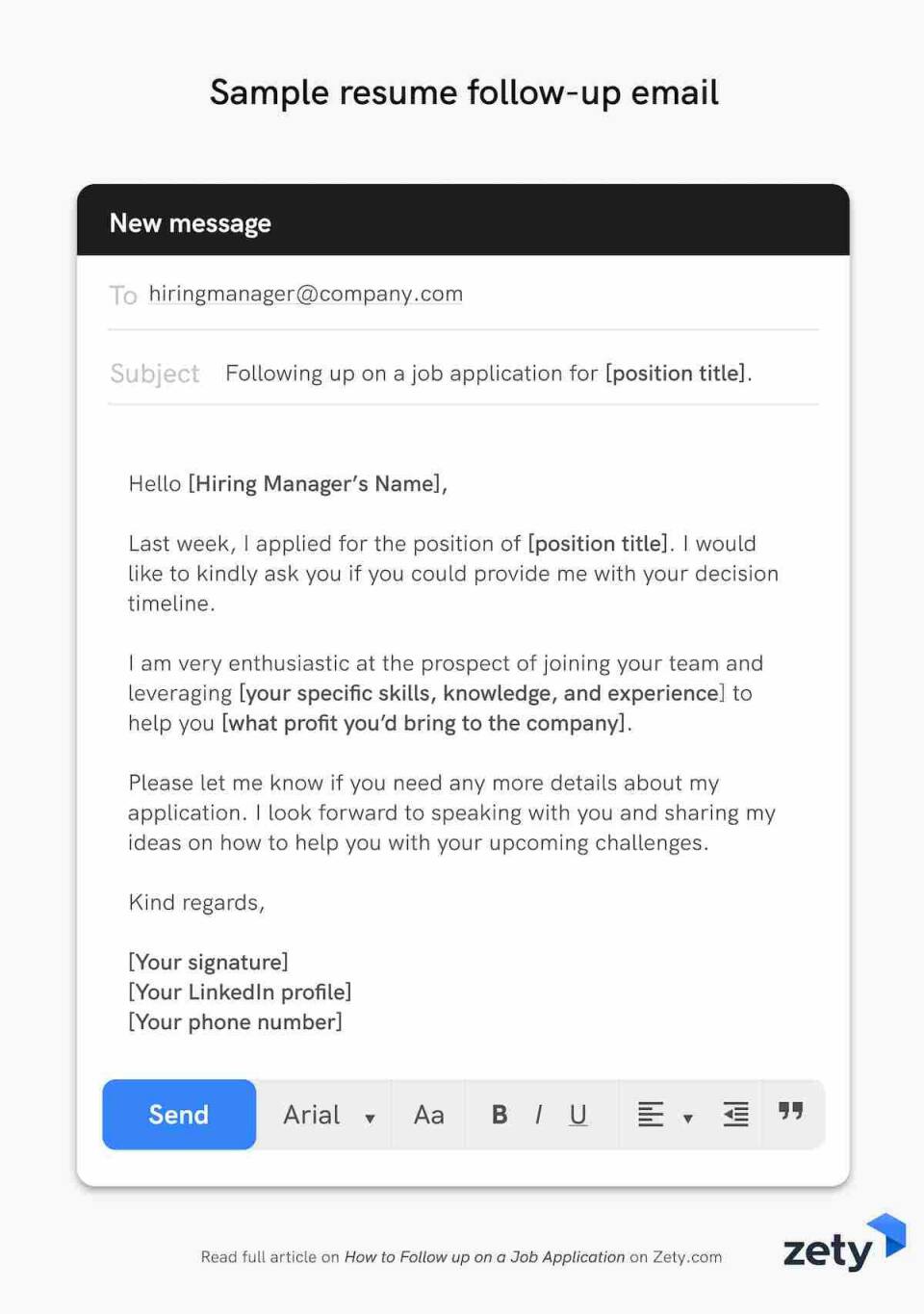 Alternatively, choose a phone as a means of communication. Remember to ask if it’s convenient for the hiring manager to speak with you first.
Alternatively, choose a phone as a means of communication. Remember to ask if it’s convenient for the hiring manager to speak with you first.
Base your phone follow-up on the script below:
Sample Phone Follow-Up on a Job Application
Hello [Hiring Manager’s Name], my name is [Your Name]. I submitted my application for the [XYZ] position two weeks ago. I just wanted to make sure you received it and to let you know that I’m still interested in the position. I’d love to discuss how I can help you with your upcoming challenges. If you need any additional information, please let me know.
Last but not least, don’t give up on applying to other companies while waiting for the response. Don’t obsess over one job posting. No matter how great a candidate you are, you might not make it for reasons beyond your control.
Already interviewed and want to write a perfect interview follow-up email? Have a look at our dedicated guide and learn how to make the most of it: How to Write a Thank-You Email After an Interview (+10 Examples)
Plus, a great cover letter that matches your resume will give you an advantage over other candidates. You can write it in our cover letter builder here. Here's what it may look like:
See more cover letter templates and start writing.
Key Takeaway
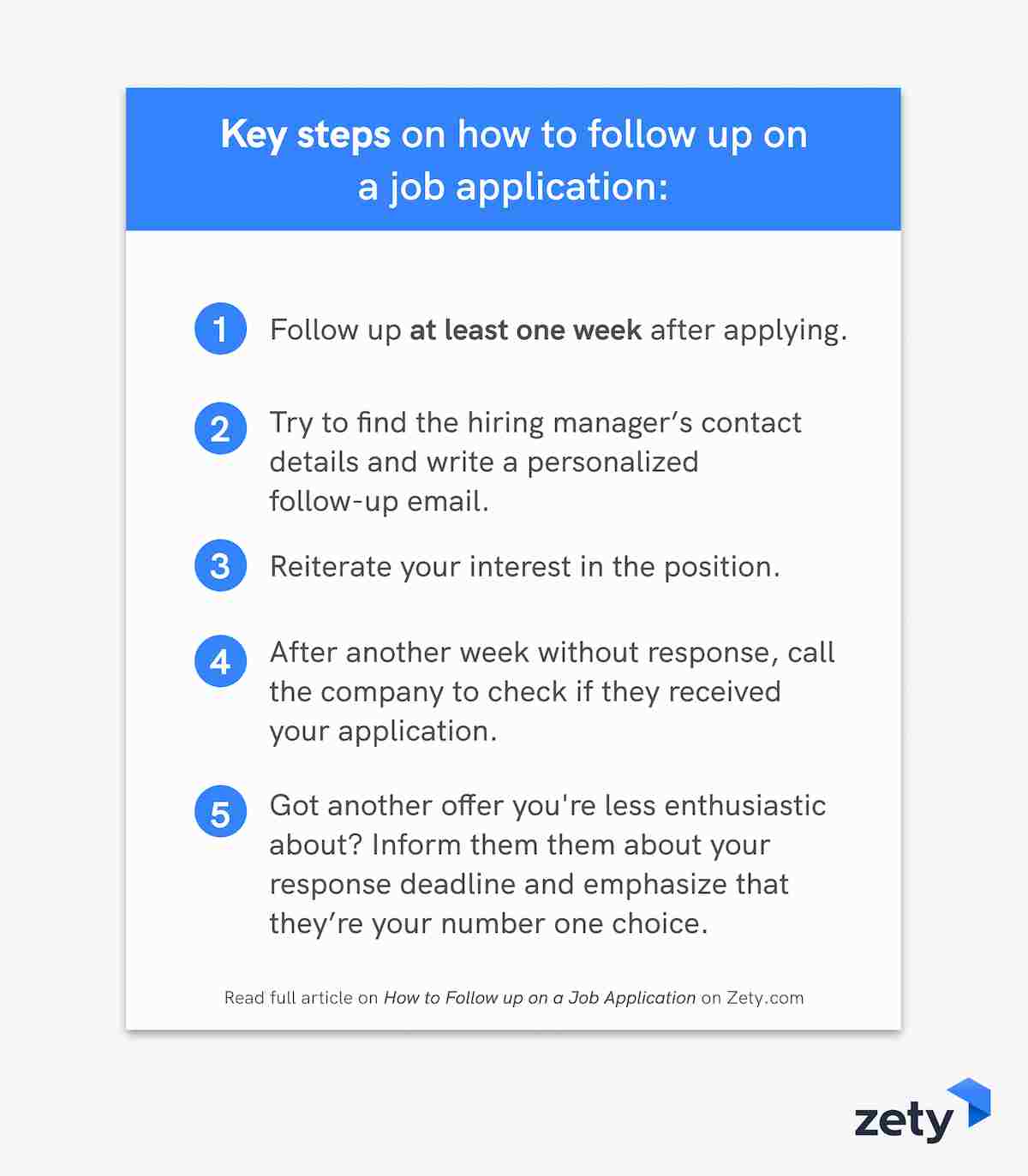 Following up on job applications might feel awkward, but it’s expected of you. Don’t think you’re “bothering” the hiring manager—you really don’t.
Following up on job applications might feel awkward, but it’s expected of you. Don’t think you’re “bothering” the hiring manager—you really don’t.
Here’s a quick recap of the key steps on how to follow up on a job application or resume:
- Follow up at least one week after applying.
- Try to find the hiring manager’s contact details and write a personalized follow-up email.
- Reiterate your interest in the position and say why you’d perform well in the job.
- After another week without a response, call the company to check if they received your application.
- If you’re offered another job, follow up with your most desired employer right away.
- Inform them about your response deadline and emphasize that they’re your number one choice.
About Zety’s Editorial Process
This article has been reviewed by our editorial team to make sure it follows Zety's editorial guidelines. We’re committed to sharing our expertise and giving you trustworthy career advice tailored to your needs. High-quality content is what brings over 40 million readers to our site every year. But we don't stop there. Our team conducts original research to understand the job market better, and we pride ourselves on being quoted by top universities and prime media outlets from around the world.
